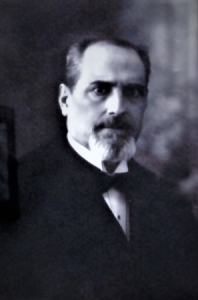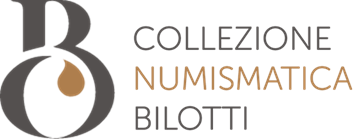Paolo Emilio Bilotti
Paolo Emilio Bilotti (Vallefiorita, 4 February 1860 – Salerno, 25 November 1927) was a renowned Italian educator, historian, and archivist who lived and worked in Salerno at the turn of the 19th century.
Biography
Bilotti was born in Vallefiorita, in the province of Catanzaro. In 1891, then thirty-one years old, Bilotti moved to Salerno, in the Campania region, to assume the role of Director of the State Archives, a position which he held until his death. At that time, the building that housed the State Archives was located on via Botteghelle. During his thirty-six year tenure as Director of the Archives, Bilotti concentrated his efforts on reorganizing the documents therein contained. Indeed, according to an 1899 report, Bilotti’s endeavors in restructuring the archival system were very successful. Undeniably, Bilotti went above and beyond his duties as Director of the State Archives. In fact, as of 1866, he took an active role in analyzing the history of the State Archives as well as making projections for its future needs.
Besides his role as Director of the State Archives, Belotti also contributed to many cultural activities in Salerno, thus showcasing historical acumen and a deep interest in the political scene of the city. Belotti was interested in the Renaissance (15th-16th centuries) and the Italian Risorgimento (1848-1871), the latter a political and social movement that opened the doors to the unification of Italy. It is not a surprise, then, that in 1907, Belotti published one of his most acclaimed works, La spedizione di Sapri. Da Genova a Sanza (The Expedition to Sapri. From Genoa to Sanza), whereby, based on extant archival documents, he painstakingly reconstructed the events that led to the 1857, Carlo Pisacane’s failed attempt at rebelling against the Kingdom of the Two Sicilies (1816-1861).
A year later, in 1908, Bilotti was nominated President of the Commissione Archeologica di Salerno (Archeological Commission of Salerno), a position which he held for many years. This position allowed him to have contacts with other similar cultural associations, as in the case of the Sopraintendenza Archeologia Belle Arti e Paesaggio per il Comune di Napoli (Government Department responsible for Monuments, the Environment, and Historical Buildings for the Naples City Council), then directed by Amedeo Maiuri (1866-1963), one of the first archeologists who worked at the excavations in Pompeii and later published on the eruption of Mount Vesuvius (79 CE). In 1924, Bilotti had a dream to found an archeological museum. Alas, his dream only came through after his death. Indeed, the Museo Archeologico Provinciale di Salerno (Provincial Archeological Museum of Salerno), housed in a former Benedictine monastery, Il Complesso di San Benedetto, was inaugurated on October 28, 1928, a year after Bilotti’s death.
Among Bilotti’s major roles as a local and regional leader stand out his 1915 position at the Loggia Massonica Carlo Pisacane di Salerno (Carlo Pisacane Masonic Lodge of Salerno). Indeed, even though as a mason he was sworn to secrecy, Bilotti strove to reconcile internal differences—as in the case of the Giovanni da Procida Masonic Lodge, named after a renowned medieval diplomat and physician from Salerno, Giovanni da Procida (1210-1298)—and promote, at a national level, a nationwide organization that supported a lay state.
In 1899, his deep interests in History led Bilotti to establish a Società di Storia Patria (Society for the History of the Nation). By doing so, Bilotti followed along the footsteps of other Italians who, around the same time, were creating similar institutions in order to preserve the rich historical past of the Italian regions that were finally unified under one nation a few decades prior. Yet, due to the events surrounding World War I (1914-1918), this society was inaugurated in 1920. Indeed, one of the byproducts of the Historical Archives that embodied the very essence of its mission was the journal Archivio Storico per la Provincia di Salerno (Historical Archives for the Province of Salerno). The first issue of this journal featured Bilotti’s article titled: “I doveri della nostra Società Patria” (The Duties of Our Nation) whereby he delineated the guidelines of the new society as well as its cultural, operational, and ideological objectives drawing upon a vast historical background, ranging from Classical Antiquity (8th century BCE-6th century CE) to the Italian Risorgimento (1848-1871).
Alas, Italian Fascism (1922-1943) took a toll on the last five years of Bilotti. In fact, by refusing to enroll in the Fascist Party Bilotti was isolated from the cultural, political, and social life of Salerno. It is no surprise then that soon after his death, the Archivio Storico per la Provincia di Salerno was eventually closed.
In the wake of World War II (1939-1945), the new Director of the Archivio di Stato di Salerno (State Archives of Salerno), Leopoldo Cassesse (1901-1960), organized a public commemoration honoring Bilotti, thus initiating the procedures for the transferring of his remains to the area dedicated to illustrious people who served the city. His tomb featured a gesso bust with his image accompanied by an epigraph from renowned historian and philosopher Benedetto Croce (1866-1952) that reads: “Paolo Emilio Bilotti//anima operosa e schiva//raccolta in dotte ricerche e studi severi//che illustrano la storia di Salerno//a lui calabro patria di adozione//lasciò di sé quel desiderio//che è gloria dei buoni” (Paolo Emilio Bilotti//fruitful and shy soul//immersed in rigorous scholarly research//that illustrates the history of Salerno//born in Calabria//left as his legacy that desire//that is only found in good men).
Works by Paolo Emilio Bilotti
- Relazione sull’Archivio di Stato in Salerno, Salerno 1899.
- Per la Calabria, Catanzaro 1905.
- “La Società Economica di Principato Citeriore.” Notizie Storiche (from 1810 to 1880), Salerno 1905.
- Gordiano Pio sul trono dei Cesari: nota storico-numismatica, Salerno: Jovane, 1907.
- La spedizione di Sapri. Da Genova a Sanza, Salerno 1907.
- Indagine intorno alla datazione di Montecorvino, Montecorvino Rovella, Tip. L’Unione, 1909
- “I doveri della nostra Società di Storia.” Archivio Storico della Provincia di Salerno. 11 (1921): 7-28.
- “Relazione amministrativa per l’esercizio 1921.” Archivio Storico della Provincia di Salerno 2. 1-2 (1922): 116-123.
- “Note tristi.” Archivio Storico della Provincia di Salerno 1-2 (1922): 124.
- “Note tristi.” Archivio Storico della Provincia di Salerno 3. (1923): 90.
- “La monografia del prof. Matteo della Corte su la Groma.” Archivio Storico della Provincia di Salerno 3.2-3 (1923): 140-151.
- “Avvenimenti e ricordi.” Archivio Storico della Provincia di Salerno 4.1-2 (1924): 90-95.
- “Il tempio di Santa Maria Maggiore in Nocera.” Archivio Storico della Provincia di Salerno 4.3-4 (1924): 161-162; v, 1-2 (1926): 91-95.
- “I Cacciatori dell’Irno. Vicende di un battaglione di volontari nel 1860.” Archivio Storico della Provincia di Salerno 5.3 (1926): 123-131.
- “Di un antico tempio in Castiglione.” Archivio Storico della Provincia di Salerno 6.1 (1927): 23-33.
- Le ragioni della Provincia sul tratto stradale Vietri-Salerno.
- Per l’arte antica nel Salernitano.
Background Bibliography
- Donato Dente, Linee di storia politica culturale e scolastica nel salernitano dal 1900 al primo quinquennio fascista, Naples: Morano, 1982.
- Leopoldo Cassese, ed. Guida storica dell’archivio di Stato di Salerno. Salerno: Reggiani, 1957.
- Italo Gallo. Profili di personaggi salernitani tra Ottocento e Novecento. Salerno: Laveglia, 2002, ISBN 88-88773-54-1.
- Alfonso Leone, and Giovanni Vitolo, eds. Guida alla storia di Salerno e della sua provincia. vol. 3. Salerno: Pietro Laveglia, 1982.
- Guida generale degli Archivi di Stato Italiani. vol. 4. Rome: 1994, ISBN 9788871250809.
- Guido Panico. Ritratto di borghesie meridionali. Roma: Avagliano, 2005, ISBN 88-8309-170-1.
- Luigi Rossi, ed. Stato, nazione e il “tradimento dei chierici”: gli storici a Salerno e il caso italiano. Convegno di studio, Fisciano 4 dicembre 2002. Salerno: Plectica, 2004
- Maria Teresa Schiavino. Catalogo dei libri antichi del fondo “Paolo Emilio Bilotti.” Salerno: Pubblicazioni dell’Archivio di Stato, 2014. SCHIAVINO, fondo Bilotti ASSA.pdf



